#all the other writers directors and producers are being ignored in favour of him
Explore tagged Tumblr posts
Text
It is always cause for concern when a fandom places a showrunner on a pedestals and starts treating them as some irreplaceable genius solely responsible for everything good about the show. It is even more alarming when the showrunner in question has already been fired from the show for allegedly creating a toxic and abusive workplace and had been previously fired from another show for the same reason. And it is even more concerning when people hear this and still insist they be rehired just because they think the quality of the show is more important than the wellbeing of the people who make it.
#x-men#x-men 97#really is disrespectful to everyone who made this show#that i see so many fans credit beau demayo (and just beau demayo) for all its success#all the other writers directors and producers are being ignored in favour of him#yes he was head writer but not sole writer#the majority of the finale was written by anthony sellitti but no one is thanking them#it's because fandoms have an unhealthy fixation with showrunners#either seeing them as creative gods to be worshiped at all cost#or making them figures of pure hate#which is annoying and leads to lots of unjust attacks over trivial things#but the worship is more dangerous because it can often lead to the worst behaviour being excuse and dismissed#we shouldn't allow that to happen again with demayo#no matter how good the show is lets not jump to support this guy no matter what
11 notes
·
View notes
Text
Just another #2Moons2 #MingKit post...

Let me talk to y’all about my favourite couple on my favourite show right now.
It’s Ming (Joong Archen Aydin) and Kit (Nine Kornchid).
Like, every single MingKit scene is a romantic epiphany.
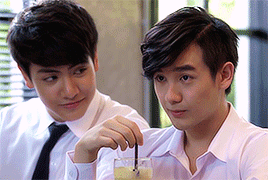
Sure they started out not interacting, so it’s easy to overlook them if you haven’t read the books (like me) or seen the first season (which I have, but the #2Moons2 reboot is on a whole other level). Their first interaction was in the Moon/Star practice room, where Ming ignores Kit in favour of talking to Beam but Kit low-key checks him out with a little look (that Nine does so well) and a once-over as Ming walks away.
Ming didn’t really acknowledge Kit until the beach trip, but we find out he’s known who Kit was...always. Then, in Ep. 9, we find out he’s been watching Kit since Grade freakin’ 9! Ming even followed him home once just so he would know where to walk Kit home if he ever worked up the courage to ask him out. He’s been watching Kit from the sidelines because, as he told Beam, Kitkat was “so small back then, such a lovely boy - just like he is now”. He was charmed that Kit’s family was so protective over their lovely little son, and I think it’s made Ming protective of him too, subconsciously at first and then very much consciously. I can just imagine confident player Ming flirting with all those girls he’d gone out with in high school and not quite sure why he’s always so distracted when cute little Kitkat walks by.
Like, look at how Ming looks at Kit:
(Spoiler alert: Joong looks at Nine like this a lot too).

That Ming adores Kit is a given; the boy is whipped and let’s thank a whipped Joong for bringing how much he stans his co-star in real life to the role of Ming; Nine is remarkable as Kit and I cannot believe this is his first acting role. Nine also obviously adores Joong and is annoyed by Joong in equal measure and it seeps through a little bit whenever Kit is with Ming.
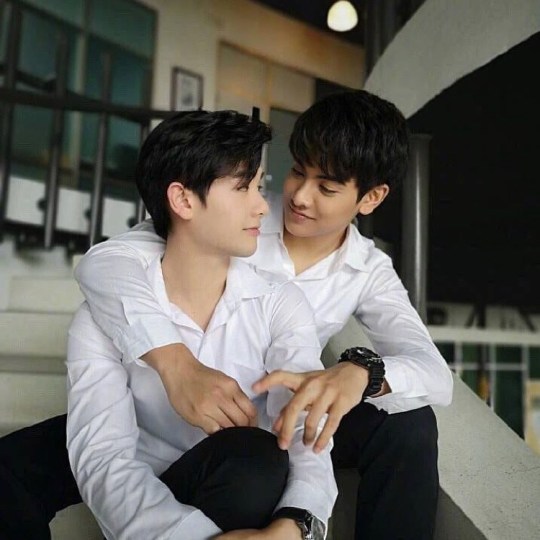
Let’s face it, these two love each other: Nine lets Joong crash in his dorm room for days at a time, he drives him wherever he needs to go, he tutors him into the night, he pushes him to study for his exams, he gets up when Joong wakes him at midnight, hungry and whiny like the growing boy he is, and makes him a delicious-looking beef curry... oh, you thought this happens on the show? Nah, fam, this is real-life.
(Spoiler alert: This is how Nine looks at Joong most of the time lol).

Nine and Joong are so, so, so good at showing what Kit and Ming are feeling on their faces and they play off each other so well because they are best friends in real life and they’re always in each other’s orbits. Their kisses are natural and sweet and sensual and romantic and they exude a soft sexiness that makes me melt.
It’s quite literally breathtaking.
Exhibit A: their first kiss
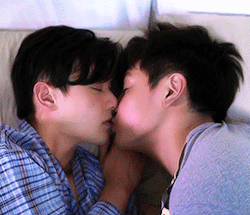
*This was also Joong’s first ever kiss and he had it with Nine! He’s also had his second, third and every other kiss since with Nine and I think that’s a little ( a lot) magical.
Exhibit B: the way they looked at each other after their first kiss
A+ acting.
Or was it?

Exhibit C: their second kiss

For science, here’s Joong and Nine reacting as they watch Ming and Kit’s first kiss on-screen:

Here’s them reacting to one of the other couple’s sharing their first kiss (#ForthBeam):

Thanks to @joongnine here’s how they hugged at their epic confession scene in Ep. 9 (which was a whole-ass MingKit episode that I have probably watched more than 50 times, yolo)

I love Ming and Kit but I love Joong and Nine: their chemistry, their friendship, the way they look at each other - that affection and trust and understanding and comfort and love that they have for one another is so rare. The fact that these very young actors feel secure and safe enough along with their co-stars (who are also lovely, talented guys), and with their production team, to demonstrate that love to us is a blessing. I’m so super thankful to the casting directors including the executive producers, director Aam Anusorn and writer Chiffon Cake for trusting their instincts about not only Joong and Nine, but also Ben and Earth (#PhaYo) and Pavel and Dome (#ForthBeam). Perfect casting, perfect characterisation - they got everything right.

There are 2 episodes left in the series and I know I’m going to feel so lost without this show. On the bright side, I still have Ming and Kit being all flirty at the gym to look forward to:

I hope #2Moons3 becomes a reality soon. I need to see these characters grow and develop further, especially now that they’ve found the loves of their lives.
In conclusion, if you haven’t seen #2Moons2 - you’re missing out. Find it on Mello Thailand’s YouTube channel here with full English subtitles: https://www.youtube.com/channel/UCdBRSSNKkMqst-qjPpnaXhA
Shout out to the fab creators of the gifs and owners of the images I got off of Google! I hope you don't mind me playing in your sandbox for this post.
Thanks for coming to my TED talk. Peace and love.

1K notes
·
View notes
Text
Forcefully Optimistic: Spider-Man’s Exit From the MCU… Might Not Be Completely Terrible?
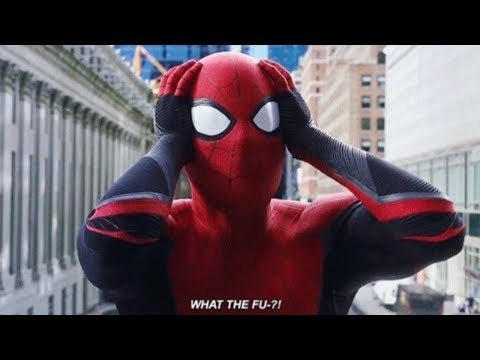
I’m not a big lover of Disney as a corporation, but there’s no denying that they’ve done some pretty amazing things with the MCU. So when the news first broke about this little lover’s spat between Sony and Disney over everyone’s web-slinging spider-child, I was (appropriately) devastated.
Then, because I both have no life and have a great love of knowing things, I started digging, sorting out the facts and the speculation and then taking a good, long look at what this means for Peter Parker and the Spider-Man franchise.
And I realize… maybe—just maybe—this isn’t completely horrible.
Let’s break it down.
The Facts:
As is the case with anything that changes and develops super-fast, there’s a lot of uncertainty and incorrect information floating around, but here are the facts that everyone can seem at agree on.
Tom Holland is still under contract to appear as Peter Parker/Spidey in a third Spider-Man movie; Jon Watts is being considered as the director for this third movie but, as his contract wrapped up with Far From Home, this isn’t a sure thing.
Under the current contract, Sony has the distribution rights of and creative control over Spider-Man and Spider-Man related characters; Disney, meanwhile, receives 5% of first-dollar gross (meaning that Disney would get 5% of ticket sales, no matter if Sony made a profit or not) and the right to include Spidey in the MCU. Disney already owns all the merchandizing rights for the character.
Disney also suggested that it get involved in other Spidey-related movies, including the Venom sequel. (For a price, of course.)
Under the contract initially proposed by Disney, the two companies would co-finance future Spider-Man movies, essentially splitting both costs and box office revenue 50/50. Therefore, while Sony would have to pay less to produce future films, the company would take a huge cut to their profits and would loose a considerable amount of control over Spider-Man and the related characters.
There are rumours that Disney has come back to play, offering a six picture deal wherein Disney would co-finance all Spider-Man related films, splitting costs and box office revenue either 30/70 or 25/75 split in Sony’s favour. Right now, neither company has confirmed this.
Sources:
https://www.businessinsider.com/sonys-spider-man-deal-with-disney-and-marvel-studios-explained-2019-8
https://www.vox.com/culture/2019/8/20/20825631/spider-man-marvel-sony-dispute-mcu-deal-film-rights
https://deadline.com/2019/08/kevin-feige-spider-man-franchise-exit-disney-sony-dispute-avengers-endgame-captain-america-winter-soldier-tom-rothman-bob-iger-1202672545/
https://boundingintocomics.com/2019/08/23/rumor-marvel-and-disney-offer-new-deal-to-sony-to-keep-spider-man-in-mcu/
The Speculation:
In Endgame, we saw the metaphorical baton being passed on to the next generation of superheroes as Black Panther, Captain Marvel, and—yup—Spider-Man played the most high-stakes game of Hot Potato ever while trying desperately to get the Infinity Stones to the Quantum Tunnel. This cemented Peter as one of Marvel’s new Big Three, meant to replace Iron Man, Captain America, and Thor.
It also, when combined with the current contract between Sony and Disney and the commercial success of Homecoming, Far From Home, and just about every other Marvel movie ever, undoubtedly resulted in Sony laughing all the way to the bank.
After all, it was their intellectual property that Disney just set up as a cornerstone for future Marvel movies.
However, Sony is also in the rather precarious position where its most valuable franchise, by far, is Spider-Man. Far From Home racked in twice as much money on its opening weekend than Sony’s second most successful film of 2019, Once Upon a Time in Hollywood. The latest installment of Men In Black, which was made by Sony-owned Columbia Pictures, has yet to break even at the theatres (and, at this rate, it probably won’t).

Source: https://www.boxofficemojo.com/studio/chart/?view2=release&view=parent&studio=sony.htm
Plus, Sony’s had a pretty spotty history with Spider-Man movies—the Raimi trilogy saw a steady decrease of gross revenue across all three films, and The Amazing Spider-Man, directed by Marc Webb, were… not received kindly. Let’s leave it at that.
Venom, for all that it was a box office success that racked in more than US$ 850 million over the course of its run, was pretty much summed up as ‘meh’ by critics, making the success of its sequel not the shoe-in that Sony would surely like. The only Spider-Man movie that’s been an absolute critical success was Into the Spider-Verse.
And, even though Sony has a whole slew of Spider-Man related movies announced, including Morbius and a Venom sequel, they’re still missing their star character—the web slinger himself.
There’s no way that Disney isn’t aware of this, of course, and considering how successful they’ve made the Marvel brand, plus and their ability to churn out (mostly) decent superhero movies year after year, it’s clear that they have an edge over Sony on that front.
However, if Into the Spider-Verse’s critical success and Venom’s financial success are any indication, it’s also clear that Sony’s been paying attention and taking notes—at least as far as superhero films are concerned. This contract breakdown could be the perfect(?) opportunity for Sony to bring Holland’s Spider-Man under their own brand, using Marvel’s successful adaptation of Peter Parker to help bolster their own Spidey Cinematic Universe.
The “Why It Might Not Be Completely Horrible”:
Whew. That was long. Okay… Let’s keep going.
Right now, we’re in this really not-good point in time where companies are merging and consolidating faster than ever. In some ways this is good, because we get standardized service across different brands and we get the possibility of an X-Men/Avengers crossover.
In other, bigger ways, though, it’s… very much not-good.
1. Oligopolies are bad for creativity.
Oligopolies are the business version of oligarchies, where a small group of people (corporations) hold all the power. Sound familiar?
Right now, Disney owns the rights to all the Marvel characters (except Spider-Man), which according to the Marvel Database Wikia, is more than 60,000 characters. The only other big player out there for superhero movies is, of course, Warner Brothers, which owns the DCEU. You can’t get much more of an oligopoly than that.
Adding one more player to the mix—Sony—doesn’t help this problem much, but it does help to distribute the characters out, giving movie goers more ways to vote with their dollars if a major company makes something that they don’t like.
Big corporations only really care about one thing: lots and lots of dollar signs. When consumers don’t have a choice where they get their consumables from, those corporations know that they’ll make money no matter what, and so they have no reason to innovate and no reason to push their creativity.
And, they don’t have any reason to listen to consumer wants or needs, either.
The result? Complacent corporations, consumers who are ignored, and a stagnant movie culture.
2. Marvel is bowing under its own weight.
With 23 movies, five discontinued series on Netflix, plus at least seven more Marvel series set to stream on Disney+, the MCU is easily one of the biggest movie franchises out there. And that doesn’t even count all the preludes, novelizations, and other add-ons.
My point is, the MCU is really, really big, and all of this bloat is starting to show.
The most recent example of this is in Far From Home, when Fury brings Peter to the underground layer and we first meet Mysterio. When Peter asks why Dr. Strange, Thor, or Captain Marvel aren’t involved in handling the Elemental threat, Fury flippantly tosses out a series of vague excuses.
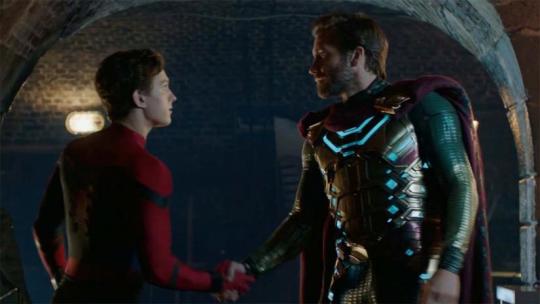
And we only cover three characters, too. If Strange isn’t available, but we’re still dealing with a guy who—it seems, at least—is wielding magic, why can’t Wong step in to help? Or at least consult? Why not call in Scarlet Witch?
We see this in Endgame, too, in the final fight scene. While it’s a great scene, I’ve heard a lot of people question why Carol Danvers even needed help getting the Infinity Stones to the Quantum Tunnel, or why she couldn’t be the one to snap her fingers. After all, she took the full force of a single Stone when she was fully human and ended up fine, so why wouldn’t she be able to withstand (or withstand better than very-human Tony) the radiation let off why the Snap?
Sure, this sounds like nitpicking, but it’s a problem that’s going to have to be addressed over and over again as we see more MCU films. Why is this character facing this conflict? Why can’t another, better suited character handle the problem instead?
As writers, we should always be asking why we’re putting a certain character in a certain situation—it’s one of the ways to ensure that our plot is an effective one. However, if the answer is “because if I put another character in their place, the plot would be resolved too quickly”… perhaps the conflict or the character choice needs to be revisited.
3. Peter’s never been allowed to stand on his own two feet.
This new, younger, less mature Peter is an absolute delight on screen, and Holland does a fantastic job bringing him to life. In particular, this worked really well for Homecoming. As the first movie that really focuses on how the ‘regular’ world is affected by the Avengers, it’s interesting to see how this happy-go-lucky teenager sees a world that is, once we really get to explore it, surprisingly different from the real world we live in.
However, the MCU has since spent most of its time exploring what makes Peter special, as opposed to what makes him so relatable—one of the very things that made him such a popular character to begin with.
With Thanos’, the Vulture’s, and Mysterio’s motivations being completely unrelated to Spider-Man’s own motivations in the movies, he doesn’t ever have to question his own motivations, opinions, attitudes, or beliefs, meaning that he doesn’t have to grow.
And when the conflict of the movie does catch up with him, he doesn’t have to think his way out of things in the same way that his comic book counterpart or previous movie iterations have always had to do—someone else will always show up. In Homecoming, it was Iron Man; in Endgame, it was Danvers; and in Far From Home, it was Happy.
And, because these MCU Spider-Man movies all always working within the confines of a larger universe, they have to always spend time setting up conflict for other characters and other movies. This takes away valuable screen time that could otherwise be spent deepening his relationship with other characters, allowing him to explore his own thoughts and feelings, or establishing his character growth.
Taking Spidey out of the MCU will let us go back to basics with his character, so to speak. By necessity, Happy, Danvers, Fury, and the Skrulls won’t be in future movies. If something goes wrong, then, Peter will have to use his own grit and intelligence and resourcefulness to get himself out of his messes, grounding the stories of possible future movies in a sense of realism that’s sense escaped the MCU (for better or worse) and better allowing him to learn and grow from his mistakes.
4. It pairs Peter up with his greatest nemeses/anti-heroes again.
As great as it was to see Spider-Man team up with Avengers, the most obvious down-side, I don’t think, as missed by anyone: if Spidey’s hanging out with another corporation’s IP, then he’s not allowed to hang around with many of the 900 plus characters developed in his own world.
With Venom being as successful as it was, having Spider-Man under Sony’s banner means that the Venom versus Spider-Man rematch we’ve all been waiting for is all the more likely. We could see the Black Cat cinematic appearance that was teased in The Amazing Spider-Man 2, but was never explored. We could see Peter interact with Sable or Kraven the Hunter, both of which have movies in Sony’s line-up. The possibilities are nigh endless.
…
…
…
Or, of course, this could all go down in a giant dumpster fire. But let’s not think about that too much, eh?

#mcu#sony#spider-man#disney v sony#marvel#i'm seriously trying so hard to be optimistic right now guys
1 note
·
View note
Text
Why you should be watching Brooklyn Nine-Nine
It's a long one, get ready.
•
Brooklyn Nine-Nine is an American police sitcom created by Dan Goor and Michael Schur. The series revolves around Jacob Peralta (Andy Samberg), an NYPD detective in Brooklyn's 99th Precinct, who comes into immediate conflict with his new commanding officer, the serious and stern Captain Raymond Holt (Andre Braugher). But despite Samberg playing the lead, it’s not “The Andy Samberg Show”, and is nothing like the Adam Sandler type movies he’s usually seen in.
Produced in Los Angeles as a single-camera comedy, Fox originally ordered thirteen episodes for its first season, eventually expanding it to 22 episodes. All episodes of Brooklyn Nine-Nine begin with a cold open, although this may not necessarily have anything to do with the actual plot of the episode. Since its debut, the series has received critical acclaim, with the cast, especially Samberg and Braugher, being singled out for praise.
The show constantly speaks out against racism, homophobia (specifically gay and trans rights), sexism, police brutality, and the stigma against mental health issues; with all the humour steering entirely away from offensive jokes and stereotypes, instead relying on jokes that are genuinely funny and fantastic comedic timing.
Characters
Brooklyn Nine-Nine contains a plethora of multi-layered characters; and the main cast (7 characters) contains only 2 white men, one of whom is half Jewish, two black men, two Latina ladies, and one white woman.
Starting with Raymond “Ray” Holt (Andre Braugher), captain of the 99th precinct, an African American, openly gay, middle-aged man in the highest position of power on the show. Like all the characters on the show, his race or sexuality is never once the punchline to a joke. He cares deeply for his husband, and his friends in the 99th precinct and acts as a father figure to many (especially Peralta).
Next, we have Jacob “Jake” Peralta (Andy Samberg), a white half Jewish man who even though acting immature and unable to deal with complex emotions at the beginning of the series, grows into a mature adult who can express his emotions well and apologises when he messes up. Peralta is also portrayed as a strong feminist, calling out anyone’s ignorant behaviour. In the fifth season, Peralta also must learn to deal and cope with mental health issues.
Amy Santiago (Melissa Fumero), is a Latina woman in a position of power (especially as of late season 4 and onwards) who’s never once sexualised because of her ethnicity. Since the beginning of the show Santiago has dealt with anxiety in various extremes, but not once is this considered a weakness, just a part of her character; and despite being romantically involved with Peralta, never is she considered “just a love interest”, but a unique and complicated character in her own right.
Charles Boyle (Joe Lo Truglio), is one of only two white men in the precinct, and his character relies heavily on his hobbies, such as a local food critic, sewing, yoga, and other traditionally non-masculine interests. He also has an adoptive son and an incredibly strong friendship with Peralta.
Then, we have Regina “Gina” Linetti (Chelsea Peretti), the epitome of self-confidence. Despite having a very close platonic relationship with Peralta, not once is she considered a “threat” to Santiago.
Terrance “Terry” Jeffords (Terry Crews) is the sergeant of the 99th precinct and African American. Jeffords is family man, with three daughters and a wife whom he loves. Not once is his relationship with his family considered to have “stripped him of his masculinity”. He also loves his work family at the 99th precinct, acting as a parental figure to them.
Finally, Rosa Diaz (Stephanie Beatriz) is another Latina woman who isn’t sexualized for her ethnicity and is in every practical sense, a badass. Recently, it’s been teased that the character will have a female love interest.
Cast
Brooklyn Nine-Nine has one of the most diverse casts on TV right now, with only 3 of its 7 main roles filled with white actors, and the bisexual Stephanie Beatriz. Not once have any of its cast been known to have done anything considered “problematic” in the slightest.
Jacob “Jake” Peralta Andy Samberg
Raymond “Ray” Holt Andre Braugher
Amy Santiago Melissa Fumero
Charles Boyle Joe Lo Truglio
Regina “Gina” Linetti Chelsea Peretti
Terrance “Terry” Jeffords Terry Crews
Rosa Diaz Stephanie Beatriz
Relationships
Brooklyn Nine-Nine portrays multiple close relationships between its characters. With childhood best friends, parental figures, ladies sticking together, a slow burn relationship, and a healthy gay marriage.
The most obvious relationship in the show is the romantic one between Peralta and Santiago, one that has been incredibly healthy and positive, with both characters supporting and caring deeply for one another.
Peralta has strong relationships with most of the characters on the show, the most obvious, after Santiago, is that which he has with Boyle. They have a strong platonic relationship that is never once considered gay by either the characters or audience nor does it “damage their masculinity”.
Another loving platonic relationship on the show is between Linetti and Peralta. The two have known each other since childhood, with Peralta even getting Linetti her job as a civilian administrator at the 99th precinct. Similarly, we see the relationship between Diaz and Peralta grow and in the later seasons, the audience can see just how important their friendship is to one another.
At the start of the show, Peralta is reluctant to show respect to Holt, thinking that Holt doesn’t know how he works and that he’s holding him back. But, throughout the show and its seasons, the two develop a strong bond, going as far as referring to the other as “son” and “dad”.
Another positive relationship in the series is that of Santiago, Diaz, and Linetti – the women of the 99. A prime example of this is when Diaz told Santiago that “You’re not the only girl at the table anymore. We work in a police force full of dudes. We gotta have each other’s backs, okay?”.
Though these are the most prominent relationships in the show, the beauty of these characters is that you could pair any two together for an interesting plot and it would still work. In fact, this is what the writers often do, with the characters in the A and B plot always mixing around.
Awards
Brooklyn Nine-Nine is generally considered overlooked, not receiving as many awards as it deserves; however, these are the awards the series has won:
2014
Golden Globes, USA
Best Television Series - Comedy or Musical
Best Performance by an Actor in a Television Series - Comedy or Musical - Andy Samberg
Primetime Emmy Awards
Outstanding Stunt Coordination for a Comedy Series or a Variety Program - Norman Howell
Critics’ Choice Television Awards
Best Supporting Actor in a Comedy Series - Andre Braugher
Online Film & Television Association
Best Supporting Actor in a Comedy Series- Andre Braugher
2015
Primetime Emmy Awards
Outstanding Stunt Coordination for a Comedy Series or a Variety Program - Norman Howell
Gracie Allen Awards
Outstanding Director – Entertainment - Julie Anne Robinson
Online Film & Television Association
Best Supporting Actor in a Comedy Series - Andre Braugher
2016
Critics’ Choice Television Awards
Best Supporting Actor in a Comedy Series - Andre Braugher
Reception
Rotten Tomatoes gave Season 1 a score of 88%. The consensus is: "Led by the surprisingly effective pairing of Andy Samberg and Andre Braugher, Brooklyn Nine-Nine is a charming, intelligently written take on the cop show format." For Season 2, it received a score of 100%. That season's consensus is: "Brooklyn Nine-Nine's winning cast, appealing characters and wacky gags make it good comfort food." Metacritic gives the first season of the show a weighted average rating of 70/100, indicating "generally favourable reviews".
Brooklyn Nine-Nine premieres on Tuesdays at 9:30 - 10:00 PM PT/ET on Fox.
#watchbrooklyn99#brooklyn nine nine#brooklyn 99#b99#jake peralta#amy santiago#raymond holt#gina linetti#rosa diaz#terry jeffords#charles boyle#andy samberg#melissa fumero#andre braugher#chelsea peretti#stephanie beatriz#terry crews#joe lo truglio
2K notes
·
View notes
Text
New Post has been published on Vintage Designer Handbags Online | Vintage Preowned Chanel Luxury Designer Brands Bags & Accessories
New Post has been published on http://vintagedesignerhandbagsonline.com/ive-seen-how-exclusive-the-fashion-world-is-can-the-new-vogue-change-that-fashion/
I’ve seen how exclusive the fashion world is. Can the new Vogue change that? | Fashion
When I was 22 I got my dream job offer: to work as an assistant at a major American fashion magazine. I was going to be independent and, I sang to myself, working with the most creative people in the world. And then I met my prospective boss.
“So your annual salary will be $17,000 (£13,000),” she said breezily. The average salary in New York at that point was just under $50,000 (£38,000).
“I – I don’t know if I can live in the city on that,” I said.
“Most of our staff,” she said, looking up at me, “have private incomes.”
I left her office sadder, wiser and unemployed.
Last week the first edition of British Vogue under Edward Enninful, the magazine’s first black and first male editor, was published. His appointment has prompted a lot of talk about fashion journalism – specifically, who is represented and who is doing the representing. After walking away from that fashion magazine, I got a job as the fashion assistant on this paper, which paid me a living wage, and also gave me ample opportunity to see the problem of representation from both sides. I covered the fashion shows for almost a decade, where I could count the number of black women in the front row on one finger: the Washington Post’s Robin Givhan, the only fashion writer to have won a Pulitzer. Because that’s how good you have to be if you’re a black woman and want to be a major player in this industry.
Early years
Born on 22 February 1972 in Ghana, Enninful moved to the UK with his parents and five siblings as a young child, setting up home in Ladbroke Grove, west London. Aged 16, he was scouted by stylist Simon Foxton, who introduced him to the world of fashion as a model.
Breakthrough
While modelling, Enninful caught the eye of Trish and Terry Jones, the founders of i-D magazine, and assisted on fashion shoots at the publication. At 18, while studying at Goldsmiths, University of London, he was appointed fashion director at i-D, launching him into the fashion stratosphere. As the youngest fashion director for a publication, he developed his reputation for producing groundbreaking shoots which captured the energy of the 90s’ creative playground. During this period he formed firm friendships with many of his lifelong collaborators, including Kate Moss and Naomi Campbell. He stayed with i-D for two decades before moving to Condé Nast’s W magazine as style director in 2011.
Greatest hits
As a stylist, Enninful has worked on countless campaigns for high-fashion houses, including Lanvin, Carolina Herrera and Tiffany & Co, and has held contributing editor positions on the American and Italian editions of Vogue. At the latter, he worked with its late editor-in-chief Franca Sozzani to produce the top-selling 2008 Black Issue, which featured only black celebrities and models.
British Vogue
On 10 April 2017, Condé Nast announced Enninful would succeed Alexandra Shulman as editor-in-chief of British Vogue, making him the first man to edit the UK edition. A strong advocate of diversity in the industry, Enninful has spoken of his desire to promote greater racial inclusivity in Vogue. Given his A-list contacts book and background as a stylist, many have speculated he will produce a more visually led publication with a heavy celebrity presence.
What others say
‘By virtue of his talent and experience, Edward is supremely prepared to assume the responsibility of British Vogue,’ his new boss, chief executive Jonathan Newhouse, said, adding that he is ‘an influential figure in the communities of fashion, Hollywood and music, which shape the cultural zeitgeist’.
In his own words
‘I grew up reading British Vogue – I am so honoured and humbled to be taking up the mantle of editor,’ he said in an interview with the publication, revealing that he was ‘most excited to tell my father about my appointment’.
Fashion, like the film and music industries, is a dream profession for a lot of young people, which means it can get away with paying pitifully low wages. For this reason, it is dominated by, if not posh people then certainly middle-class ones and, racial inequality being what it is, white people. Given how much fashion dictates pop culture, this is a problem.
People don’t like to have their privilege pointed out to them; they get huffy and think they’re being told they’re bad at their job, when they’re just being told they didn’t face the hurdles others do. The former editor of Vogue, Alexandra Shulman, fell into that trap when she was interviewed by the Guardian last week. Asked about a photo of her staff in her final issue, in which every single person was white, she replied: “The idea that we were having a kind of tea party when we made literally hundreds of millions of pounds of profit, I find offensive.” But no one is saying that. They’re saying how bizarre it was to have a staff of over 50 – in London, for God’s sake! – and for them to be entirely one race. “Relatively few [non-white people] came up through the pipeline, for whatever reason,” Shulman said, betraying remarkably little curiosity as to why that might be.
The fashion industry still holds up Caucasian as the beauty ideal, and, really, why would a non-Caucasian woman want to work in a business where the best she can hope for is to be deemed “exotic”? Just look at the differing attitudes to Naomi Campbell and Kate Moss by the British fashion media: both raised in south London, and both with a fair few scandals in their past. And yet it’s Moss who is touted as – to use one recent magazine line – “the best of British”; she, not Campbell, is the one magazines put on the cover of their special issues.
Membership Event: Guardian Weekend Live
When an industry is dominated by one demographic, blind spots occur. Solange Knowles and Lupita Nyong’o recently complained about, respectively, the Evening Standard magazine and Grazia photoshopping their hair out of covershoots. In all honesty, my initial response was bemusement: surely, I thought, the magazine had just been making space on the covers for text? But, despite not being able to work for peanuts when I was 21, I am a privileged white woman and therefore am blithely ignorant about what a black woman’s hair represents to black women. And while ignorance isn’t the same as racism, it is also not an excuse.
For far too long, magazine editors have been able to hide behind the myth that magazines with black cover models don’t sell. In fact, they do: American Vogue covers featuring Michelle Obama, Beyoncé and Nyong’o in 2014 performed as well as those featuring white women. A much bigger problem is that many advertisers don’t want to see their products on them, because they don’t think black people buy luxury goods. And as magazine sales plummet, editors are beholden to those advertisers.
It will be fascinating to see if Edward Enninful can change this. But if fashion magazines are now dying, with younger readers rejecting the sluggish glossies in favour of fashion bloggers, editors have only themselves to blame. They reinforced the idea that beauty was white, and for a long time, readers believed them. No more.
Source link
0 notes